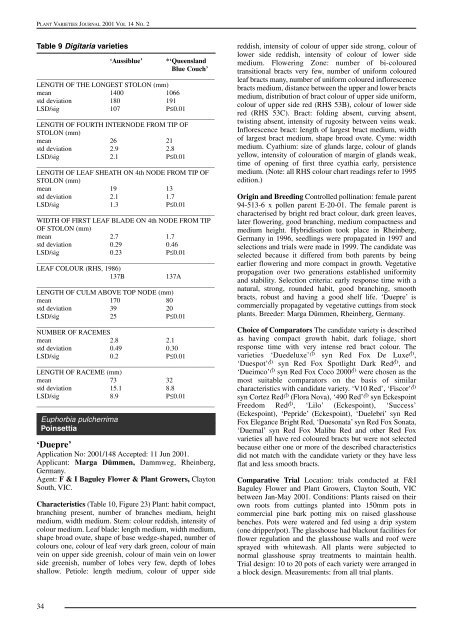47. Volume 14- Number 2 - IP Australia
47. Volume 14- Number 2 - IP Australia
47. Volume 14- Number 2 - IP Australia
You also want an ePaper? Increase the reach of your titles
YUMPU automatically turns print PDFs into web optimized ePapers that Google loves.
PLANT VARIETIES JOURNAL 2001 VOL <strong>14</strong> NO. 2<br />
Table 9 Digitaria varieties<br />
‘Aussiblue’ *‘Queensland<br />
Blue Couch’<br />
____________________________________________________<br />
LENGTH OF THE LONGEST STOLON (mm)<br />
mean <strong>14</strong>00 1066<br />
std deviation 180 191<br />
LSD/sig 107 P≤0.01<br />
____________________________________________________<br />
LENGTH OF FOURTH INTERNODE FROM T<strong>IP</strong> OF<br />
STOLON (mm)<br />
mean 26 21<br />
std deviation 2.9 2.8<br />
LSD/sig 2.1 P≤0.01<br />
____________________________________________________<br />
LENGTH OF LEAF SHEATH ON 4th NODE FROM T<strong>IP</strong> OF<br />
STOLON (mm)<br />
mean 19 13<br />
std deviation 2.1 1.7<br />
LSD/sig 1.3 P≤0.01<br />
____________________________________________________<br />
WIDTH OF FIRST LEAF BLADE ON 4th NODE FROM T<strong>IP</strong><br />
OF STOLON (mm)<br />
mean 2.7 1.7<br />
std deviation 0.29 0.46<br />
LSD/sig 0.23 P≤0.01<br />
____________________________________________________<br />
LEAF COLOUR (RHS, 1986)<br />
137B 137A<br />
____________________________________________________<br />
LENGTH OF CULM ABOVE TOP NODE (mm)<br />
mean 170 80<br />
std deviation 39 20<br />
LSD/sig 25 P≤0.01<br />
____________________________________________________<br />
NUMBER OF RACEMES<br />
mean 2.8 2.1<br />
std deviation 0.49 0.30<br />
LSD/sig 0.2 P≤0.01<br />
____________________________________________________<br />
LENGTH OF RACEME (mm)<br />
mean 73 32<br />
std deviation 15.1 8.8<br />
LSD/sig 8.9 P≤0.01<br />
____________________________________________________<br />
Euphorbia pulcherrima<br />
Poinsettia<br />
‘Duepre’<br />
Application No: 2001/<strong>14</strong>8 Accepted: 11 Jun 2001.<br />
Applicant: Marga Dümmen, Dammweg, Rheinberg,<br />
Germany.<br />
Agent: F & I Baguley Flower & Plant Growers, Clayton<br />
South, VIC.<br />
Characteristics (Table 10, Figure 23) Plant: habit compact,<br />
branching present, number of branches medium, height<br />
medium, width medium. Stem: colour reddish, intensity of<br />
colour medium. Leaf blade: length medium, width medium,<br />
shape broad ovate, shape of base wedge-shaped, number of<br />
colours one, colour of leaf very dark green, colour of main<br />
vein on upper side greenish, colour of main vein on lower<br />
side greenish, number of lobes very few, depth of lobes<br />
shallow. Petiole: length medium, colour of upper side<br />
34<br />
reddish, intensity of colour of upper side strong, colour of<br />
lower side reddish, intensity of colour of lower side<br />
medium. Flowering Zone: number of bi-coloured<br />
transitional bracts very few, number of uniform coloured<br />
leaf bracts many, number of uniform coloured inflorescence<br />
bracts medium, distance between the upper and lower bracts<br />
medium, distribution of bract colour of upper side uniform,<br />
colour of upper side red (RHS 53B), colour of lower side<br />
red (RHS 53C). Bract: folding absent, curving absent,<br />
twisting absent, intensity of rugosity between veins weak.<br />
Inflorescence bract: length of largest bract medium, width<br />
of largest bract medium, shape broad ovate. Cyme: width<br />
medium. Cyathium: size of glands large, colour of glands<br />
yellow, intensity of colouration of margin of glands weak,<br />
time of opening of first three cyathia early, persistence<br />
medium. (Note: all RHS colour chart readings refer to 1995<br />
edition.)<br />
Origin and Breeding Controlled pollination: female parent<br />
94-513-6 x pollen parent E-20-01. The female parent is<br />
characterised by bright red bract colour, dark green leaves,<br />
later flowering, good branching, medium compactness and<br />
medium height. Hybridisation took place in Rheinberg,<br />
Germany in 1996, seedlings were propagated in 1997 and<br />
selections and trials were made in 1999. The candidate was<br />
selected because it differed from both parents by being<br />
earlier flowering and more compact in growth. Vegetative<br />
propagation over two generations established uniformity<br />
and stability. Selection criteria: early response time with a<br />
natural, strong, rounded habit, good branching, smooth<br />
bracts, robust and having a good shelf life. ‘Duepre’ is<br />
commercially propagated by vegetative cuttings from stock<br />
plants. Breeder: Marga Dümmen, Rheinberg, Germany.<br />
Choice of Comparators The candidate variety is described<br />
as having compact growth habit, dark foliage, short<br />
response time with very intense red bract colour. The<br />
varieties ‘Duedeluxe’ A syn Red Fox De Luxe A ,<br />
‘Duespot’ A syn Red Fox Spotlight Dark Red A , and<br />
‘Dueimco’ A syn Red Fox Coco 2000 A were chosen as the<br />
most suitable comparators on the basis of similar<br />
characteristics with candidate variety. ‘V10 Red’, ‘Fiscor’ A<br />
syn Cortez Red A (Flora Nova), ‘490 Red’ A syn Eckespoint<br />
Freedom Red A , ‘Lilo’ (Eckespoint), ‘Success’<br />
(Eckespoint), ‘Pepride’ (Eckespoint), ‘Duelebri’ syn Red<br />
Fox Elegance Bright Red, ‘Duesonata’ syn Red Fox Sonata,<br />
‘Duemal’ syn Red Fox Malibu Red and other Red Fox<br />
varieties all have red coloured bracts but were not selected<br />
because either one or more of the described characteristics<br />
did not match with the candidate variety or they have less<br />
flat and less smooth bracts.<br />
Comparative Trial Location: trials conducted at F&I<br />
Baguley Flower and Plant Growers, Clayton South, VIC<br />
between Jan-May 2001. Conditions: Plants raised on their<br />
own roots from cuttings planted into 150mm pots in<br />
commercial pine bark potting mix on raised glasshouse<br />
benches. Pots were watered and fed using a drip system<br />
(one dripper/pot). The glasshouse had blackout facilities for<br />
flower regulation and the glasshouse walls and roof were<br />
sprayed with whitewash. All plants were subjected to<br />
normal glasshouse spray treatments to maintain health.<br />
Trial design: 10 to 20 pots of each variety were arranged in<br />
a block design. Measurements: from all trial plants.

















